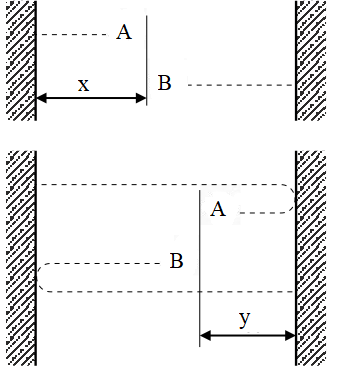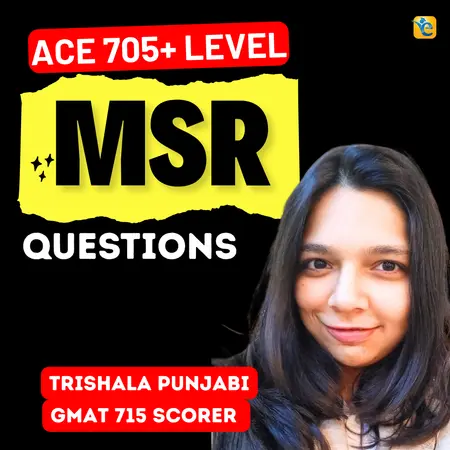Events & Promotions
|
|

GMAT Club Daily Prep
Thank you for using the timer - this advanced tool can estimate your performance and suggest more practice questions. We have subscribed you to Daily Prep Questions via email.
Customized
for You
Track
Your Progress
Practice
Pays
Not interested in getting valuable practice questions and articles delivered to your email? No problem, unsubscribe here.
- Nov 22
11:00 AM IST
-01:00 PM IST
Do RC/MSR passages scare you? e-GMAT is conducting a masterclass to help you learn – Learn effective reading strategies Tackle difficult RC & MSR with confidence Excel in timed test environment - Nov 23
11:00 AM IST
-01:00 PM IST
Attend this free GMAT Algebra Webinar and learn how to master the most challenging Inequalities and Absolute Value problems with ease. - Nov 25
10:00 AM EST
-11:00 AM EST
Prefer video-based learning? The Target Test Prep OnDemand course is a one-of-a-kind video masterclass featuring 400 hours of lecture-style teaching by Scott Woodbury-Stewart, founder of Target Test Prep and one of the most accomplished GMAT instructors.
Kudos
Bookmarks
N
Be sure to select an answer first to save it in the Error Log before revealing the correct answer (OA)!
Difficulty:
(N/A)
Question Stats:
75% (02:55) correct 25%
(02:54)
wrong
25%
(02:54)
wrong  based on 47
sessions
based on 47
sessions
History
Date
Time
Result
Not Attempted Yet
Bunuel's Word Problems Diagnostic Test
Distance/Rate Problems, Mixture Problems, Overlapping Sets, Work/Rate Problems, Word problems.

Please note that the questions are ranked in ascending level of difficulty according to the timer stats.
Distance/Rate Problems, Mixture Problems, Overlapping Sets, Work/Rate Problems, Word problems.
Please note that the questions are ranked in ascending level of difficulty according to the timer stats.
Grading & How to use this test:
- Please time yourself and allocate 2 mins per question
- 15 - 16 or more correct, your Word Problems score is Q50+
- 13 - 14 correct, your Word Problems score is Q49
- 11 - 12 correct, your Word Problems score is Q48
- 9 - 10 correct, your Word Problems score is Q47
- 7 - 8 correct, your Word Problems score is Q46
- 5 - 6 correct, your Word Problems score is Q45
Note that levels 7 and 8 are very hard questions. These questions are well within the GMAT parameters but their difficulty is driven by the amount of time you will need to spend to solve each of the questions. Do not be discouraged if you are not able to solve any of the Level 7 or 8 questions.
------------------- EASY -------------------
LEVEL 1:
What is the average (arithmetic mean) number of runs per game scored by The New York Yankees last season ?
(1) Last season, The New York Yankees played 160 games
(2) Last season, The New York Yankees scored four runs per game in exactly 1/5 of their games, five runs per game in exactly 3/4 of their games, and nine runs per game in exactly 1/20th of their games.
B
Out of 25 Gryffindor students, 16 play chess, and 11 play quidditch. How many of Gryffindor students play both chess and quidditch ?
(1) 3 Gryffindor students play neither chess, nor quidditch.
(2) For every 3 Gryffindor students who play neither chess, nor quidditch, there are 5 Gryffindor students who play both chess and quidditch.
D
LEVEL 2:
Fanny and Alexander are y miles apart and are traveling in a straight line toward each other at a constant rate of 25 mph and x mph respectively. What is the value of x?
(1) 1.5 hours before they meet they were 135 miles apart
(2) y = 360 miles
A
Three people Ann, Bob and Colin have a total of $1.80 between them, each having a different amount. Does Ann have the most money?
(1) Ann has $0.6
(2) Bob has $0.5
A
------------------- MEDIUM -------------------
LEVEL 3:
In the morning, John drove to his mother's house in the village at an average speed of 60 kilometers per hour. When he was going back to town in the evening, he drove more cautiously and his speed was lower. If John went the same distance in the evening as in the morning, what was John's average speed for the entire trip?
(1) In the evening, John drove at a constant speed of 40 kilometers per hour.
(2) John's morning drive lasted 2 hours.
A
LEVEL 4:
Ten slips of paper, numbered 1 through 10, are placed in a bag. If three slips are chosen at random from the bag without replacement and one of the slips chosen is numbered 7, what is the sum of numbers on the three chosen slips of paper?
(1) The sum of two of the numbers chosen is 16.
(2) The sum of two of the numbers chosen is 14.
B
Mbappé has two types of sneakers: red and blue. When packing for the World Cup, he puts equal number of sneakers in each of his suitcases. The first suitcase has 27% of all his red sneakers. Does the first suitcase have less than 25% of his blue sneakers ?
(1) No suitcase has more red sneakers than the first one.
(2) The first suitcase has between 23% and 27% of his blue sneakers.
D
------------------- HARD -------------------
LEVEL 5:
The ratio of the number of marbles in boxes X and Y was 5 to 8. After some number of marbles were transferred from box Y to box X, the ratio of the number of marbles in boxes X and Y became 7 to 6. What is the total number of marbles in the two boxes?
(1) Initially the number of marbles in box Y was between 45 and 100.
(2) After the transfer, the number of marbles in box X became between 45 and 100.
E
De Bruyne and Mbappe start racing from the bottom of a 100-meter hill to the top and then back to the bottom by the same route. Each of them runs up at his constant rate and back down with twice that constant rate. What would be the distance between the two, when the fastest one finishes the entire 200-meter race ?
(1) Mbappe and De Bruyne cross each other when Mbappe has run 140 meters.
(2) Mbappe reaches the top of the hill 10 seconds before De Bruyne does.
A
LEVEL 6:
On a joint company picnic, 160 employees of Alpha Ltd, Beta Ltd and Gamma Ltd were engaged in several football matches. The average (arithmetic mean) number of goals scored by the employees of Alpha Ltd was 10, and the average (arithmetic mean) number of goals scored by the employees of Beta Ltd was 12.2. Was the average (arithmetic mean) number of goals scored by all 160 employees more than 11 ?
(1) The 75 employees of Gamma Ltd scored the average of 12 goals.
(2) The ratio of the number of employees of Alpha Ltd to Beta Ltd to Gamma Ltd was 16:1:15.
A
A poll conducted on the Wembley Stadium revealed that 1/6 of Messi fans are also fans of Mbappe, 2/5 of Mbappe fans are also fans of De Bruyne, and 3/4 of De Bruyne fans are also fans of Ronaldo. What is the probability that a random Messi fan on the stadium, is also a fan of Ronaldo ?
(1) There is not a single Mbappe fan who is also not a fan of Messi.
(2) For every Messi fan, who is also a fan of Mbappe, there are 5 Messi fans, who are also fans of De Bruyne.
E
------------------- VERY HARD -------------------
LEVEL 7:
In a survey of an Olympic team members, 1/6th of them said they do not watch movies during their free time, of those, 3/4th said they also do not play video games during their free time. Is the number of the Olympic team members who do not play video games equal to 90 ?
(1) 210 members of the Olympic team said that they watch movies and play video games during their free time
(2) 15 members of the Olympic team said that they play video games but do not watch movies during their free time
A
A poll conducted among the members of a football fan club, revealed that 100 of them root for Portugal, 150 of them root for France, and 200 of them root for Argentina. Also, 120 of them root for exactly two of the three teams. How many members does the fan club have ?
(1) Equal number of members root for Portugal only and for Argentina only.
(2) For every 2 members of the club who root for none of the three teams, there is 1 member who roots for all three of the teams.
B
LEVEL 8:
Odyssey runs from the Trojan Horse, which does not move, to the gates of Troy and back to the Trojan Horse by the same path. Was his average speed less than 20 kilometres per hour for the entire journey ?
(1) Odyssey's average speed from the Trojan Horse to the gates of Troy was greater than 40 kilometres per hour.
(2) Odyssey's average speed from the gates of Troy to the Trojan Horse was less than 10 kilometres per hour.
B
Two cyclists start moving simultaneously from opposite ends of a straight track towards each other back and forth. Cyclists' speeds are constant, but one is faster than the other. First time, the cyclists meet each other at a distance of x meters from the nearest end of the track. Second time, on the way back, they meet y meters from the other end of the track. What is the length of the track?
(1) x = 720 meters
(2) y = 400 meters
C
- OTHER DIAGNOSTIC TESTS:
Attachment:
WP.png
Experience GMAT Club Test Questions
Yes, you've landed on a GMAT Club Tests question
Craving more? Unlock our full suite of GMAT Club Tests here
Want to experience more? Get a taste of our tests with our free trial today
Rise to the challenge with GMAT Club Tests. Happy practicing!

Kudos
Bookmarks
Question 1 - Official Solution:
What is the average (arithmetic mean) number of runs per game scored by The New York Yankees last season?
(1) Last season, The New York Yankees played 160 games.
This statement is clearly insufficient, as we don't know the total number of runs.
(2) Last season, The New York Yankees scored four runs per game in exactly \(\frac{1}{5}\) of their games, five runs per game in exactly \(\frac{3}{4}\) of their games, and nine runs per game in exactly \(\frac{1}{20}\) of their games.
Let's check what the sum of the fractions mentioned totals to.
\(\frac{1}{5} + \frac{3}{4} + \frac{1}{20} = 1\)
Hence, we have the number of runs for each fraction of games which sum up to a total of 1. Thus, assuming the total games to be \(x\), we can calculate the average:
\(\frac{\frac{1}{5}*x*4 + \frac{3}{4}*x*5 + \frac{1}{20}*x*9}{x}\)
\(x\) gets reduced and we get:
\(\frac{1}{5}*4 + \frac{3}{4}*5 + \frac{1}{20}*9 = 5\)
Sufficient.
Answer: B
What is the average (arithmetic mean) number of runs per game scored by The New York Yankees last season?
(1) Last season, The New York Yankees played 160 games.
This statement is clearly insufficient, as we don't know the total number of runs.
(2) Last season, The New York Yankees scored four runs per game in exactly \(\frac{1}{5}\) of their games, five runs per game in exactly \(\frac{3}{4}\) of their games, and nine runs per game in exactly \(\frac{1}{20}\) of their games.
Let's check what the sum of the fractions mentioned totals to.
\(\frac{1}{5} + \frac{3}{4} + \frac{1}{20} = 1\)
Hence, we have the number of runs for each fraction of games which sum up to a total of 1. Thus, assuming the total games to be \(x\), we can calculate the average:
\(\frac{\frac{1}{5}*x*4 + \frac{3}{4}*x*5 + \frac{1}{20}*x*9}{x}\)
\(x\) gets reduced and we get:
\(\frac{1}{5}*4 + \frac{3}{4}*5 + \frac{1}{20}*9 = 5\)
Sufficient.
Answer: B
Kudos
Bookmarks
Question 2 - Official Solution:
Out of 25 Gryffindor students, 16 play chess, and 11 play Quidditch. How many Gryffindor students play both chess and Quidditch?
We are given that:
{Total} = {Chess} + {Quidditch} - {Both} + {Neither}
25 = 16 + 11 - {Both} + {Neither}
{Both} = 2 + {Neither}
(1) Three Gryffindor students play neither chess nor Quidditch.
This gives {Neither} = 3. Thus, {Both} = 2 + {Neither} = 2 + 3 = 5. Sufficient.
(2) For every three Gryffindor students who play neither chess nor Quidditch, there are five Gryffindor students who play both chess and Quidditch.
This implies that {Neither} : {Both} = 3 : 5, which gives \({Neither} = \frac{3}{5} * {Both}\). Substituting this into {Both} = 2 + {Neither}, we get a linear equation with one unknown, {Both}, hence we can solve for it. Sufficient.
Answer: D
Out of 25 Gryffindor students, 16 play chess, and 11 play Quidditch. How many Gryffindor students play both chess and Quidditch?
We are given that:
{Total} = {Chess} + {Quidditch} - {Both} + {Neither}
25 = 16 + 11 - {Both} + {Neither}
{Both} = 2 + {Neither}
(1) Three Gryffindor students play neither chess nor Quidditch.
This gives {Neither} = 3. Thus, {Both} = 2 + {Neither} = 2 + 3 = 5. Sufficient.
(2) For every three Gryffindor students who play neither chess nor Quidditch, there are five Gryffindor students who play both chess and Quidditch.
This implies that {Neither} : {Both} = 3 : 5, which gives \({Neither} = \frac{3}{5} * {Both}\). Substituting this into {Both} = 2 + {Neither}, we get a linear equation with one unknown, {Both}, hence we can solve for it. Sufficient.
Answer: D
















